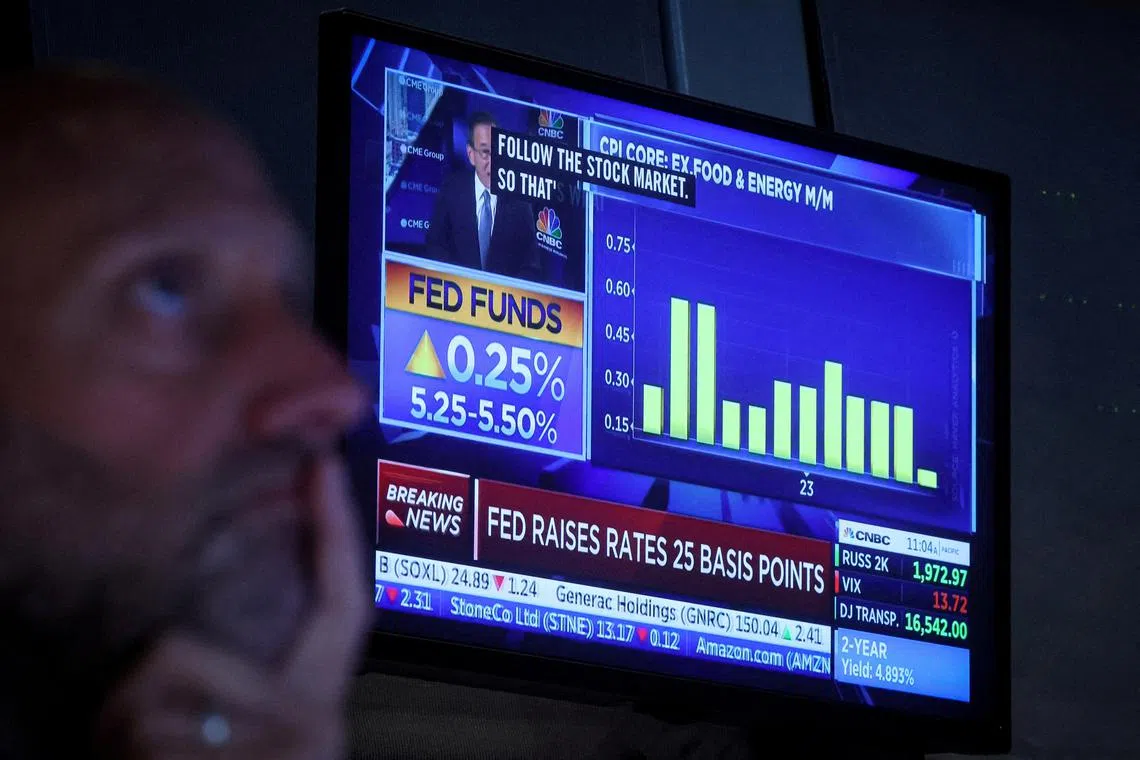Why a global rout in government bonds is worrying
Sign up now: Get ST's newsletters delivered to your inbox

In the US Treasury market, the bedrock of the global financial system,10-year bond yields have shot up to 16-year highs.
PHOTO: REUTERS
Follow topic:
LONDON – The world’s biggest bond markets are in the throes of another rout as a new era of higher-for-longer interest rates takes hold.
In the US Treasury market, the bedrock of the global financial system, 10-year bond yields have shot up to 16-year highs. In Germany, they have touched their highest since the 2011 euro zone debt crisis. Even in Japan, where official rates are still below 0 per cent, bond yields are back at levels seen in 2013.
As government borrowing costs influence everything from mortgage rates for home owners to loan rates for corporates, there is plenty of reason for angst.
Here’s a look at why the bond rout matters.
1. Why are global bond yields soaring?
Markets are increasingly reckoning with interest rates staying high.
With inflation, excluding food and energy prices, elevated, and the United States economy resilient, central banks are pushing back against rate cut bets.
Traders now see the US Federal Reserve cutting rates to only 4.7 per cent, from the 5.25 per cent to 5.5 per cent currently, up from the 4.3 per cent they anticipated in late August.
This is compounding worries about the fiscal outlook following a US credit rating downgrade in August by Fitch, citing high deficit levels. Highly indebted Italy raised its deficit target last week.
Higher deficits mean more bond sales just as central banks offload their vast holdings, so longer-dated yields are rising as investors demand more compensation.
Many investors were also betting that bond yields would drop, so are extra sensitive to moves in the opposite direction, analysts say.
2. How far could the sell-off go?
US data shows that the economy remains resilient, with Monday’s upbeat manufacturing survey pushing Treasury yields up again.
This is no surprise, and analysts do not rule out a rise in 10-year Treasury yields to 5 per cent, from 4.7 per cent now.
When a bond yield rises, its price falls.
But Europe’s economy has deteriorated, so selling should be more limited there, as bonds typically do better when an economy weakens, and most big central banks have signalled that they are done with rate increases.
3. Why does it matter and should we worry?
Ten-year US Treasury yields have risen to their 230-year average for the first time since 2007, Deutsche Bank data shows, highlighting the challenge of adjusting to higher rates.
Bond yields determine governments’ funding costs, so the longer they stay high, the more they feed into the interest costs countries pay.
This is bad news as government funding needs remain high. In Europe, slowing economies will limit how much governments can unwind fiscal support.
But higher yields are welcome to central bankers, doing some of their work for them by raising market borrowing costs.
US financial conditions are at their most restrictive in nearly a year, a closely watched Goldman Sachs index shows.
4. What does it mean for global markets?
The ripple effects are broad. First, rising yields set the stage for a third straight year of losses on global government bonds, hurting investors long betting on a turnaround.
As for stocks, the bond yield surge is starting to suck money away from buoyant markets. On Tuesday, the Dow Jones Industrial Average lost more than 400 points and turned negative for the year. The S&P 500 is down roughly 7.5 per cent from more than one-year peaks hit in July.
Focus could turn back to banks, big holders of government bonds sitting on unrealised losses, a risk put on the radar by Silicon Valley Bank’s collapse in March.
“(The bond sell-off) will have a strong impact on banks that hold long-end Treasuries,” said Mr Mahmood Pradhan, head of macro at Amundi Investment Institute.
“The longer it persists, the more sectors it will hit.”
Higher US yields also mean an ever-stronger US dollar, piling pressure on other currencies, especially Japan’s yen. REUTERS

